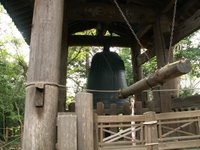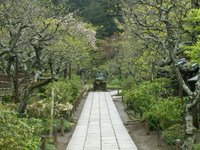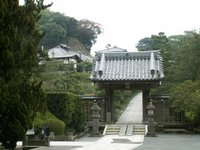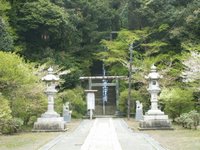It's 7am And I Can't Think Of A Catchy Title So I'll Name It 'Kamakura'
Kamakura is a hilly area about one hour South-West of Yokohama. All I knew is that it houses many shrines, temples, the Great Buddha (Daibutsu), and I could escape city-life for the day. The weather wasn’t great; it was overcast and muggy but there was no rain all day so there were very few tourists.
I jumped on the train and headed to Kita-Kamakura; the north part of Kamakura. About two-thirds of the way there, into countryside, I saw a huge white statue of a woman in the mountains. The train sped past so I didn’t get a photo but next time I go I’ll be prepared. More on her later, however.
At Kita-Kamakura, the first temple I encountered was next to the station. This was when my plan of seeing many of them in one day hit the first hurdle. The temples here aren’t like the others I’ve seen around Tokyo; they are big areas in themselves containing ten or so smaller temples, shrines and other buildings in them. Ah well, a good excuse to come back.
History time. About 700 years ago, Japan was attacked twice by Mongolia; the most unprecedented national crisis Japan had ever met. After Japan fought back, Tokimune Hojo, a Zen Master, envisioned the temple Engaku-Ji to remember the souls of all the soldiers. One of the largest temples in Kamakura, Engaku-Ji has eighteen separate branch temples within its walls and runs zazen (meditation) courses even now. For those cultured among us, it is the setting for Kawabata Yasunari’s 1949 novel ‘Thousand Cranes’. Additionally, it houses the largest bell in Kamakura, which is said to guide the souls spared by the king of hell back to earth.





Tokei-Ji, built in 1285 was nicknamed the ‘divorce temple’ because at that time only men were allowed to petition for divorce. However, it served as a refuge sanctuary and if a woman spent three years here she could divorce her husband. A much quieter temple, whose gardens stretch back into caverns within the hillside.


Next on my list was Jochi-Ji. Nestled in a cypress wood, established in 1238, it has been designated as holding an ‘Important Cultural Asset’: three wooden statues on the central altar which represent, from left to right, Amida ‘past’, Shaka ‘present’ and Miroku ‘future’.



The last of the temples I saw in Kita-Kamakura was Kencho-Ji; the oldest Zen training monastery in Japan and constructed between 1227-63. Work was completed in the fifth year of the Kencho era, from which it takes its name. The founder of Kencho-Ji was Rankei Doryu, whose teachings are expressed by his following quotation:
If you have lost your true self, all phenomena bring you nothing but annoyance.To give you scale, the first picture is a map just of Kencho-Ji.
If you discover your essence of mind, you can follow nothing but the true path.





I didn’t take too many photographs as it felt a little sacrilegious, although the other tourists took plenty. It was in Kencho-Ji that I had my first experience of having to remove my shoes before entering a religious building. Behind the building was the most serene pond I’ve ever seen. It’s supposedly shaped like the kanji character for heart/mind.




Where do these steps lead? The answer, to more steps. And after that, more steps. And a few more. Then some more. And then you reach the half-way mark. Anyway, a ‘few’ steps later and you reach the top of Kencho-Ji. A small shrine and tea-shop are at the top and I’ve since been told that on a clear day you can see Mount Fuji but as of yet still no sighting of him. Doesn’t the last picture look like something out of Resident: Evil!



I thought I was going to have a heart attack from the steps, and when I saw some elderly Japanese people at the top looking like they’d literally just been for a stroll in the park, I commented on how tired and hot I was. In very broken Japanese of course. The man replied in good English and introduced me to his wife and their daughter. I only remember the daughter’s name; ‘Sakura’ (cherry blossom) which is very popular, perhaps like ‘Sarah’ or ‘Rachel’ in the UK.
I found out that they were taking a similar route as me, and they offered to show me around. They were so friendly and patient, and it allowed the man to practice his English too.
(They took the shrines very seriously, and so the photos stop for a while here. Another reason to go back and see the places again)
The first place they showed me was Hachiman-gu Shrine. This was the biggest and most touristy so far. My new best friend explained a few Buddhist and Shinto rituals as well as some of the history. Afterwards they paid for me to enter the botanical gardens. I think at this point the two women wanted to know the English names for the plants, but they had to settle with the colours instead. We had some jokey arguments about whether things were red or pink, violet or purple, and green and blue*.
The other side of the temple led to Kamakura’s main road, Wakamiya-oji, a broad boulevard sided by boutiques, patisseries and Zen-style restaurants, which leads all the way to the beach. At Kamakura station, we took the steam train to Hase, home of the Great Buddha. At this point, the man told me that the woman statue I saw before was the female equivalent of the Daibutsu, and that they face each other.
I can imagine the Daibutsu being very busy on weekends and holidays but it was relatively quiet, and free; they paid for me again. I’ve seen pictures of the Buddha, but it’s not until you see it that you realise how peaceful it looks and massive it is. Even in my photos you can’t really appreciate the scale (the family are in some of them). The bronze statue weighs 121 tons, is 13.35 metres tall, was constructed in 1252 and has survived every natural disaster you can imagine; tidal waves and earthquakes have destroyed temples and structures around it yet the Buddha has always stood tall.






We walked back to the train station, and I was to go one way and they went another. The man told me how to change in Yokohama several times, which was very unnecessary but kind of him. We said our goodbyes and they crossed the station for trains in the other direction. (The old stations meant that you just crossed the track when the trains weren’t there).
All of a sudden the old man ran over to my side to tell me once again how to change trains, when the bars came down and the trains approached. I was so embarrassed and the two women looked like they saw the funny side, but it was quite awkward. I got into my train and left the man standing there, on the wrong platform. I couldn’t look at him so I kept my head down until the train left. Bless him.
*The last pair may seem less confusing to distinguish, but as it turns out, the Kanji for green and blue is the same, so it’s not as easy to separate.



2 comments:
Philip, can you imagine me with the colours? They would all be blue, blue or blue. The day out what an experience for you, you describe it so well.... do you have an english guide book for all the information? or do you look at the internet. You are certainly getting around. perhaps you should be a travel presenter/ guide?
You really make us feel as though we took all of the steps, steps, step......... what a kind family to adopt you.... a bit embarrassing for them to pay... people can be so kind? is it a culture thing? Great blog keep it going love Dad
Your blog is wonderful, descriptive and interesting. Keep it going.
Love
Mum
Post a Comment